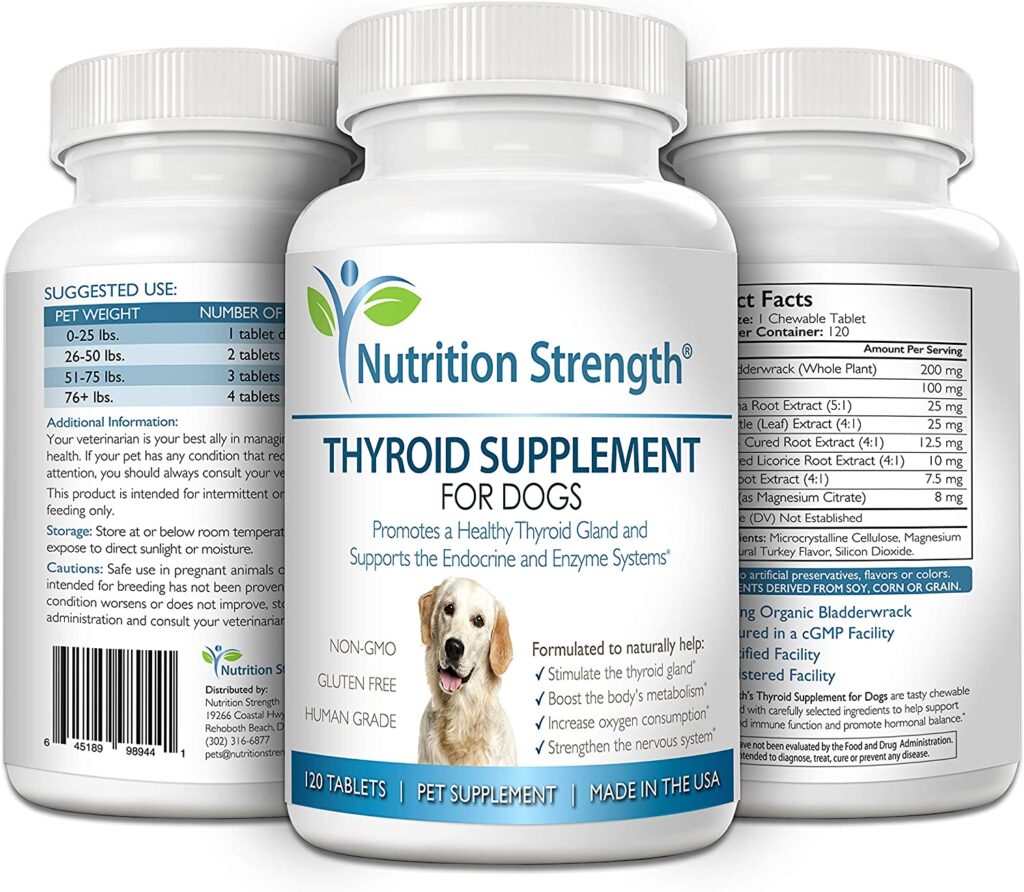Thyroid Problems in Dogs: What You Need to Know
Thyroid problems in dogs occur much more often than many pet owners realize. While they are typically manageable, knowing that your dog has one in the first place is essential, in order for you to take steps to address the issue and keep your pet healthy.
The thyroid gland is one of the most vital organs, yet it is also ignored and misunderstood. Knowing more about the thyroid gland and its functions and thyroid gland anomalies might help us make better treatment options and plans. Dog owners must understand the thyroid in health and sickness.
To assist you in better understanding your dog’s condition below is some information on the more prevalent thyroid illnesses that can afflict dogs.
Table of contents
- What Does the Thyroid Do?
- Hypothyroidism
- Autoimmune Thyroiditis
- Hyperthyroidism
- The Takeaway
- Nutrition Strength Thyroid Supplement for Dogs
Check out our Nutrition Strength Thyroid Supplement for Dogs here.
What Does the Thyroid Do?
The thyroid gland, which has two lobes, is located in the neck. It makes iodine-containing hormones, the most important of which are T3 and T4, which affect various bodily functions. Thyroid hormones, in general, influence metabolic rate. Body processes become slow when there is a lack of hormones. They will run too fast if there is overproduction.
Thyroid hormone secretion is regulated by reactions that begin in the hypothalamus. The brain produces a thyrotropin-releasing hormone. It stimulates the pituitary gland to produce a thyroid-stimulating hormone, promoting the thyroid gland to create T3 and T4.
Thyroid hormones affect a wide range of cellular functions. Some of their actions take minutes to hours to complete, while others take several hours or even days.
Thyroid hormones, in appropriate amounts, collaborate with other hormones to develop tissues, such as growth hormones and insulin. They can, however, contribute to the degradation of proteins and tissues when released in overmuch.
Thyroid disease in dogs has two different points of view.
- Hypothyroidism is defined by a reduction in thyroid hormone production. As a result, we can see slowed metabolic rate. The thyroid gland is destroyed in most instances of hypothyroidism in dogs. A pituitary gland tumor is a less common cause, yet it can induce pituitary hormone deficits.
- Hyperthyroidism, which is an increase in the levels of thyroid hormone production, is rare in dogs but far more common in cats.
Hypothyroidism
In more than 95 percent of cases, hypothyroidism in dogs is caused by the loss of the thyroid gland itself. A pituitary gland tumor is another reason, which frequently results in a deficiency of other pituitary hormones.
Dogs can be born with a thyroid gland that does not develop or operate correctly in a small percentage of cases. Hypothyroidism can be present in puppies born with a pituitary abnormality, such as pituitary dwarfism.
Hypothyroidism is most frequent in dogs between the ages of four and ten. It mainly affects medium- to large-breed dogs, and it’s uncommon in miniature breeds. The Golden Retriever, Doberman Pinscher, Irish Setter, Miniature Schnauzer, Dachshund, Cocker Spaniel, and Airedale Terrier are the most often afflicted breeds.
Males and females are equally susceptible to hypothyroidism. However, spayed females may be at a higher risk than unspayed canines.
Signs of Hypothyroidism
Thyroid hormone shortage impacts the operation of many organ systems; hence symptoms vary. Most symptoms are caused by a slowed metabolism, which causes mental drowsiness, lethargy, aversion to or incapacity to exercise, and weight gain without increasing hunger.
Some dogs struggle to stay warm and seek sources of warmth. Dryness, excessive shedding, delayed hair regeneration, and hair thinning or hair loss (typically in the same pattern on both sides) are all frequent changes in the skin and coat, which are occasionally coupled with enhanced pigmentation overworn spots.
The skin can thicken in more severe instances, especially on the forehead and face, resulting in puffiness and enlarged skin folds over the eyes. Some dogs have a “tragic” facial expression due to the puffiness and mild sagging of the top eyelid.
Neurologic diseases, such as an enlarged esophagus (megaesophagus), laryngeal and facial nerve paralysis, and severe dizziness (vestibular illness), are occasionally linked to a low concentration of thyroid hormones in the bloodstream.
Unfortunately, therapy may not be able to alleviate these symptoms. Severe hypothyroidism can potentially cause a coma in rare circumstances.
Hypothyroidism in non-neutered dogs can lead to a variety of reproductive issues. Females may experience erratic or non-existent heat cycles, rendering them sterile or reduced litter survival. Infertility can be caused by a lack of libido, tiny testicles, poor sperm count, or infertility in males.
Thyroid hormones are essential for the growth and development of the skeleton and central nervous system throughout pregnancy and the first few months of life.
Dwarfism and decreased mental development are common in animals born with thyroid deficiency or who develop it early in life. Depending on the reason for hypothyroidism, an enlarged thyroid gland may be discovered.
Diagnosing Hypothyroidism
A thorough examination of symptoms and laboratory testing is required to correctly diagnose hypothyroidism, including the proof of low thyroid hormone blood concentrations (especially T4). Your veterinarian may need additional tests, such as:
- Regular blood tests;
- Antibody analysis;
- Thyroid-stimulating hormone injection;
- Ultrasonography;
- Thyroid gland scintigraphy;
- Therapeutic medication trial.
Other diseases may cause similar symptoms and lower the level of T4 in the blood. T4 blood levels are frequently lower in certain breeds, such as Greyhounds, Scottish Deerhounds, and racing Alaskan sled dogs. Furthermore, some medications, such as glucocorticoids, can lower T4 levels in the blood.
Treatment of Hypothyroidism
The deficient thyroid hormone is increased or replaced as part of the treatment. The thyroid hormone replacement most commonly used in dogs is thyroxine (T4). The quantity of improvement in indicators can be used to gauge therapy effectiveness.
Treatment must usually be taken for four to eight weeks before any coat or body weight changes can be assessed. Thyroid hormone concentrations in the blood are also checked to see if the thyroid hormone dosage must be adjusted.
Thyroid hormone levels are typically examined once or twice a year once the dosage has been established. Treatment is usually for the rest of one’s life. If the condition does not improve after taking thyroid supplements for dogs, another issue may be blamed, and more testing should be done.
Autoimmune Thyroiditis
Some dog breeds are vulnerable to autoimmune thyroiditis. The immune system targets the thyroid gland, causing this condition more frequent in the Akita, Doberman Pinscher, Beagle, and Golden Retriever.
Although hypothyroidism is a common symptom of autoimmune thyroiditis, it can also be a sign of another condition, such as systemic lupus erythematosus or panendocrinopathy. This is one of the many reasons why a proper diagnosis of hypothyroidism is critical.
Hyperthyroidism
Hyperthyroidism is characterized by an excess of thyroxine, which boosts metabolism. Hyperthyroidism is uncommon, and it most usually arises as a result of thyroid cancer in dogs. It might also be caused by medicine used to treat hypothyroidism, in which the body produces insufficient thyroid hormones.
Compared to other dog breeds, the Siberian Husky, Golden Retriever, and Beagle have a higher risk of thyroid cancer. Most dogs with cancer-related hyperthyroidism are elderly (9 years old or older).
Signs оf Hyperthyroidism
The most typical symptoms are significant weight loss and continuous hunger. Excessive drinking and urination, as well as vomiting, difficulty swallowing, changes in voice / bark, aggressive behavior, hyperactivity, and a lump on the dog’s neck (where the thyroid gland is situated), may be observed.
Trouble breathing, coughing, and collapse are other possible signs of an overactive thyroid. It can also affect the heart (e.g., altered rhythm, murmurs, rapid rate) and circulatory system (e.g., high blood pressure / hypertension).
Diagnosing Hyperthyroidism
Palpitation of the gland, which enlarges as disease advances, is frequently used to make a preliminary diagnosis. A chemical blood profile, a complete blood count, and a urinalysis are standardized testing.
The most prevalent result of the shape is a high quantity of T4 in the blood serum, confirming a hyperthyroidism diagnosis. T4 levels may be within the normal range in some circumstances, making hyperthyroidism diagnosis more challenging.
This is especially true in the early stages of a disease. If your dog shows hypothyroidism symptoms but the blood tests are not indicative, you will need to visit your veterinarian for further blood testing.
Your veterinarian may need to run many tests to arrive at a valid diagnosis. Thyroid gland scintigraphy is one of the methods, and it uses a diagnostic radioisotope. After that, it creates a two-dimensional image of a bodily radiation source. As a result, the method can detect hyperthyroidism and locate aberrant thyroid tissue.
Chest X-rays can be used to identify pulmonary metastasis, and thoracic radiography and echocardiography can determine the degree of cardiac illness.
Treatment оf Hyperthyroidism
If medications that limit thyroid hormone production can be utilized, outpatient treatment is typically adequate. The dose of thyroid medication for dogs can be altered when the thyroid is hyperactive. This can happen due to taking medicines for hypothyroidism, and the symptoms will generally lessen.
Inpatient therapy and monitoring are required if the thyroid gland is surgically removed or radioactive iodine is used. Surgical thyroidectomy is recommended when just one lobe of the thyroid gland is damaged, as removing both thyroid lobes may result in hypothyroidism.
The subsequent hyperactivity of the remaining lobe of the thyroid gland is another issue that can develop following surgical excision of the diseased thyroid gland.
If hyperthyroidism is caused by a thyroid tumor in dogs, the metastatic potential of cancer will determine the surgical option. The tumor’s closeness to the esophagus and main arteries can make surgery difficult, if not impossible.
However, in rare circumstances, a piece of cancer can be excised and the dog treated with radioactive medications. The prognosis is determined by how the tumor has spread into the surrounding tissues.
Because radioiodine is a radioactive therapy, it is only used in a limited medical facility. Depending on the state you live in and the rules in place, your dog may need to be hospitalized for several days to a few weeks after being treated with radioactive medicine for the radioactive material to pass most of the body before being touched by family members.
After you’ve brought your dog home, you’ll still need to take precautions to avoid a harmful reaction to the radioactive therapy. Preventive measures will be recommended by your veterinarian.
Dietary changes are typically not necessary once the main symptoms caused by high thyroid hormone levels in the body have been treated. Nonetheless, they may be required to treat or prevent problems associated with hyperthyroidism, such as renal impairment.
The Takeaway
In dogs, thyroid diseases are rather prevalent conditions. The most common endocrine thyroid disorder in dogs is acquired hypothyroidism. Other thyroid issues might arise, such as thyroid cancer or congenital hypothyroidism. Because this gland is involved in so many metabolic processes in an animal’s body, problems occur quickly.
Changes in the thyroid gland should definitely be taken into account. It is impossible to prescribe treatment for your pet independently, as the veterinarian chooses the medicines and their dosage.
Owners can ensure that their pet is adequately fed and well cared for at home. The veterinarian should be consulted if any thyroid conditions in dogs are suspected.
Nutrition Strength Thyroid Supplement for Dogs
Check out our Nutrition Strength Thyroid Supplement for Dogs here.
Nutrition Strength Thyroid Supplement for Dogs, Support for Hypothyroidism in Dogs with Organic Bladderwrack, Promotes Normal Function of Endocrine and Enzyme Systems are tasty chewable tablets, which are specially made to promote normal endocrine, hormonal and enzyme systems in dogs.
Carefully formulated to help your four-legged friend get the most out of every moment in life, our premium, delicious thyroid supplement for dogs works by:
- Supplying the herbs and co-factors needed to support optimal thyroid and immune function in dogs.
- Helping to maintain your dog’s energy levels.
- Supporting the adrenal glands and the peripheral body systems affected by the thyroid gland.
- Promoting normal levels of thyroid hormones in dogs.
- Keeping the thyroid gland healthy supports optimal metabolism and thermoregulation.
Our supplement’s organic bladderwrack ingredient supplies the iodine, which your pet’s thyroid gland converts into thyroid hormones: thyroxine (T4) and triiodothyronine (T3). That, in turn, stimulates the metabolism of almost every tissue in the canine body.
Used daily, our thyroid tablets for dogs promote a healthy thyroid function, which increases both the metabolism and oxygen consumption and strengthens the nervous system, while supporting high energy levels and contributing to the growth and development of your pet, so that they enjoy a long-term active and healthy lifestyle.
Image source: Wikimedia / Jerry Reynolds.





Buenas tardes!
Necesito comprar Nutrition Strength Thyroid Supplement for Dogs pero la unica opcion de compra es mediante Amazon y este producto esta agotado, que otra opcion me dan para comprarlo?
Hello,
Our Nutrition Strength Thyroid Supplement for Dogs is in stock, please check again and you should be able to buy it.
Best regards